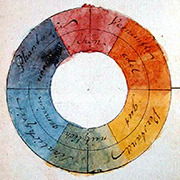"In Farben gezeichnet". Orchestration and Form in Early Nineteenth-Century Symphonies and Overtures between Germany and Italy
Dr. Federica Di Gasbarro

The color circle to symbolize the human mind and soul life, pen-and-ink drawing with watercolor by Johann Wolfgang Goethe, 1809 (© Wikimedia Commons).
In the late 17th century art theorists were engaged in a lively dispute over the relationship between drawing and colour, some challenging the prevailing view that line, as the essential expression of an idea, was primarily responsible for the perception of form, while colour was merely an ornamental addition. The famous Querelle du coloris emerged much later in the field of music. In the mid-19th century, the opinion prevailed that orchestration consisted of a mere addition of colour to a picture already completely outlined in its main features (Fink 1836). This distinction between content and "colouristic effect" (Hanslick 1854) was reflected in the concept of a hierarchical separation between central (melody, harmony, and rhythm) and peripheral (timbre, dynamics, texture, etc.) musical features (Handschin 1948). This hierarchy is still present today in the theories of form and the analytical practice of this repertoire.
The project aims to trace the emerging awareness of the structural value of sound in the music of the early 19th century, when composers were critically confronting the classical formal canon and searching for new dramaturgical strategies, also through orchestral means. The analysis of symphonies and overtures composed in Germany and Italy in the first decades of the century and the study of historical sources drawn from the compositional process and theoretical-aesthetic reflections in both countries will make it possible to assess the fundamental role played by orchestration in structuring and perceiving form. Consequently, this work will seek to broaden today's analytical tools primarily oriented towards pitch and interval structures. The overall goal is to have dialogue between two areas of musicological research that have remained separate until now, namely the theory of orchestration and the theory of form. An additional focus is to reconsider historiographic reflections on cultural transfers between Germany and Italy, beyond stylistic dualism (Dahlhaus 1980) and the polarization between the genre of the (German) symphony and that of the (Italian) opera.
Dr. Federica Di Gasbarro
Researcher Music History
Biography
Publications
+39 06 66049254
f.digasbarro[at]dhi-roma[dot]it

